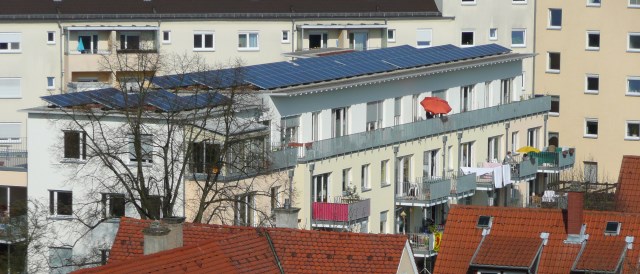A recent report at USA Today throws together a lot of disparate problems to explain why renewables are “losing their shine” in Europe. As Craig Morris points out, feed-in tariffs are not subsidies, Europe is not Germany, and we still overlook the main driving force behind the German energy transition.

Solar Panels on the roof of residential houses in Heidelberg – Community ownership and environmental concerns are two key reasons to understand the broad acceptance of higher electricity costs. (Photo by 4028mdk09, CC BY-SA 3.0)
USA Today has produced a refreshingly long article on renewables in Europe. Admittedly, it suffers from the American tendency to look at “both sides of the issue,” thereby giving space to doubters of climate change (“global warming stopped 16 years ago,” one skeptic claims). I have also dealt with the one-trillion-euro price tag for the energy transition elsewhere along with the two non-issues of power storage and offshore wind. So let’s focus on three other issues, starting with “renewables in Europe.”
True, the EU has targets for renewables by 2020. Likewise, EU member states have generally all adopted feed-in tariffs as the policy mechanism to reach those targets. But that is where the similarities end.
Each member state pursues its own energy policy; a few years ago, Brussels merely required each member state to publish targets, which need not be ambitious. The difference between member states becomes salient when we consider the second bit of confusion: feed-in tariffs are not subsidies.
As the USA Today journalist explains, “subsidies… spurred an unsustainable, artificial boom in solar, wind, and other renewables, which some analysts say have contributed to financial meltdown on the continent.” By “subsidies,” the author means feed-in tariffs – a term that is never mentioned.
You see, feed-in tariffs not part of any governmental budget but are a surcharge to ratepayers similar to the way Social Security is a pay-as-you-go scheme (and not thought of as a subsidy). The EU has even ruled that feed-in tariffs do not constitute “state aid.”
Still, the situation differs greatly from one country to the other. Take Spain – the journalist quotes a Spanish expert saying, “it’s government subsidized electricity prices that have given rise to the current problems in Europe, not renewable energy.” Indeed, as I explained years ago, the Spanish government artificially limits the retail rate (which Germany does not), so that the full surcharge for renewables could not be passed on to ratepayers and will therefore instead be absorbed by governmental budgets – meaning it will remain unpaid and be passed on to future generations with interest. But this is a Spanish problem, not a European one.
The author seems to think that “subsidies have been cut” because of austerity measures, but in fact lower feed-in tariffs were the goal all along. FITs cover the cost of an investment and provide additional payment for a profit (generally 5-7 percent). So what USA Today calls subsidy cuts is, in reality, success in lowering the cost of renewables.
Finally, the author also does not understand why Germans don’t mind the cost more. “Germans are willing to pay for renewable energy out of concern for the environment and climate change,” we read – and later: “Nowhere is this concern [about climate change] more acute than in Germany” which plans to “have the entire country running on 80 percent renewable energies by the year 2050.”
In fact, Germans only aim to get 80 percent of their electricity from renewables, not all of their energy. In contrast, Denmark plans to have 100 percent renewables for electricity, heat, and motor fuel by 2050.
Like the Danes, who have the highest retail power rates in Europe, Germans don’t mind the extra cost of renewables because they pay the money back to themselves. Germans see investments in renewables as creating local jobs and local added value.
More specifically, while others try to encourage utilities to go renewable, the Germans just make the power themselves. Yet, the USA Today article does not even mention community ownership of renewables, probably because the issue – the main reason why Germany is successful with renewables – is so unfamiliar to Americans.
Craig Morris (@PPchef) is the lead author of German Energy Transition. He directs Petite Planète and writes every workday for Renewables International.